Today’s Current Affairs: 16th September 2025 for UPSC IAS exams, State PSC exams, SSC CGL, State SSC, RRB, Railways, Banking Exam & IBPS, etc
Table of Contents
Zircon Missile:
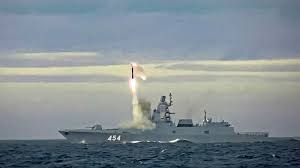
Russia recently said that it had fired a Zircon (Tsirkon) hypersonic cruise missile at a target in the Barents Sea.
- The 3M22 Zircon (Tsirkon), NATO code-named SS-N-33, is a scramjet-powered hypersonic cruise missile developed by Russia.
- Initially designed to target naval assets, the missile has evolved to include land-attack capabilities, making it an important tool for precision strike missions.
- It entered service in 2022, with initial deployments on Project 22350 Admiral Gorshkov-class frigates.
- It has an estimated length of 9 meters (30 feet) and a diameter of 60 cm (24 inches), with an estimated weight of between 3,000 and 4,000 kg (3–4 tons).
- The missile is powered by a two-stage propulsion system.
- The first stage consists of a booster engine powered by solid fuel, which accelerates the missile to supersonic speeds.
- After reaching a certain speed, the scramjet engine in the second stage ignites, utilizing liquid fuel to accelerate the missile to hypersonic speeds.
- Its speed—reaching up to Mach 9—makes it extremely difficult to intercept.
- The operational range of the Zircon is reported to be around 400–450 km (250–280 miles) at low altitudes, while it can extend up to 1,000 km (620 miles) in a semi-ballistic trajectory.
- It is capable of carrying both conventional and nuclear warheads, providing it with a versatile role in modern warfare.
- The missile uses a combination of inertial navigation, radar homing, and plasma stealth to navigate towards its target.
- One of the key features of the Zircon is its ability to generate a plasma cloud during hypersonic flight, which absorbs radio waves and makes the missile more difficult to detect by radar.
- This phenomenon is known as plasma stealth.
Pink Tax:

While there are no specific laws in India to address the issue of Pink Tax, the National Consumer Disputes Redressal Commission ruled that companies must follow fair pricing policies and avoid gender-based price discrimination.
- The Pink tax is neither a real tax nor is it a government-imposed fee.
- It is a term used to describe the extra cost that some companies charge for products marketed to women compared to similar products marketed to men.
- This means women might end up spending more money for the same product that men get for less.
- When companies charge more for pink (female) products compared to blue (male) versions, the extra revenue does not go to the government but benefits the companies
- Pink toys, haircuts, dry cleaning, razors, shampoos, body lotions, deodorants, facial care, skincare items, beauty care, clothing, T-shirts, jeans, salon services ,etc. suffer the tax.
- The term “Pink Tax” is believed to have originated in the U.S. in California in 1994.
- It emerged following the realisation that brands in various cities consistently charged women higher prices for goods and services than men.
- As per a study done in the U.S., personal care products targeting women were 13% costlier than men’s. Further, women’s accessories and adult clothing were 7% and 8% more expensive.
- The “pink tax” is not prohibited by law in India, and there are no set government regulations on this pricing practice.
- Female-targeted goods and services prices are determined based on market dynamics and demand.
- While there is limited research on the pink tax in India, surveys indicate price variations between products for women and men.
- While there are no specific laws in India to address the issue of Pink Tax, the National Consumer Disputes Redressal Commission ruled that companies must follow fair pricing policies and avoid gender-based price discrimination.
Dongsha Islands:
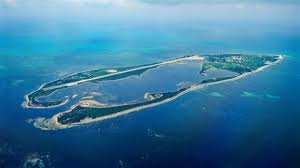
Taiwan’s Coast Guard Administration (CGA) confirmed recently that it had dispatched vessels to repel both a Chinese coast guard ship and a Chinese fishing boat operating near Dongsha Island.
- The Dongsha Islands, also known as the Pratas Islands, are a small group of three islands located in the northern part of the South China Sea.
- It lies approximately 445 km southwest of Kaohsiung, Taiwan, and 320 km southeast of Hong Kong.
- The Dongsha Islands are governed by Taiwan. There are no permanent residents. But Taiwanese marines are stationed
- These islands are characterized by a circular coral atoll structure.
- They are composed primarily of clastic coral and reef flats approximately 15 miles (24 kilometers) in diameter, enclosing a lagoon about 10 miles (16 kilometers) in diameter.
- The island group includes Dongsha Island, being the only island above sea level, about 1 mile (1.6 kilometers) long and a little over 0.5 miles (0.8 kilometers) wide, and Northern Vereker and Southern Vereker atolls, both of which are below sea level.
Garra nambashiensis: New Species Of Fresh Water Fish
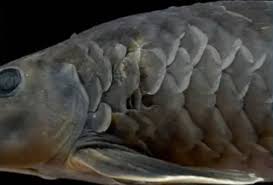
Researchers recently discovered a new species of freshwater fish, Garra nambashiensis, in Manipur.
- Garra nambashiensis is a new species of freshwater fish which belongs to the Labeonine family.
- It was discovered in Taretlok, a tributary of the Chindwin River, near Nambashi Valley in Manipur’s Kamjong district.
- It was collected from “swift-flowing riffles (shallow sections of a river or stream) with algae-covered gravel beds and mixed substrate comprising cobbles, boulders, pebbles, sand, fine silt, and coarse sediments.
- The species features a quadrate-shaped proboscis, 7-8 acanthoid tubercles on the anterolateral margin, black spots on the opercle, 8-11 dorsal-fin scales, and six black stripes extending to the hypural plate.
- It typically measures 90-140 mm (9-14 cm), and locals call it Nutungnu.
- Currently, 60 species of Garra have been recorded from various river systems in the Northeast, encompassing the Eastern Himalayan and Indo-Burma regions.
- Of these, 32 are grouped in the ‘proboscis species group’ and occur in the Chindwin, Brahmaputra, Barak, and Kaladan river systems.
- Eight species have been recorded from the Chindwin river system alone, including the recently described G. chingaiensis.
INS Androth:
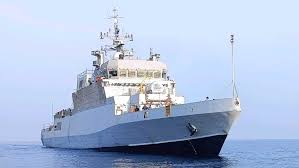
The Indian Navy has received the second indigenously built anti-submarine warfare-shallow watercraft INS Andorth.
- INS Androth draws its name from Androth Island in the Lakshadweep archipelago.
- It is the second of eight anti-submarine warfare-shallow watercraft (ASW-SWC) built by Garden Reach Shipbuilders and Engineers (GRSE), Kolkata.
- The ASW SWC ships have been indigenously designed and constructed as per the Classification Rules of Indian Register of Shipping (IRS)at GRSE, Kolkata
- It is approximately 77 meters in length and it is the largest Indian Naval warships.
- The ship is propelled by a diesel engine-waterjet combination, which allows for high speed and efficient maneuverability in shallow waters.
- It is equipped with state-of-the-art lightweight torpedoes, indigenous ASW rockets, and advanced shallow water SONAR,
- It enables effective submarine detection and engagement in littoral zones.
- It strengthens the Navy’s Anti-submarine, coastal surveillance and mine laying capabilities.
- It is built by using over 80 percent indigenous content, reflecting growing domestic capabilities and reducing dependency on imports.
International Electrotechnical Commission:

India will host the 89th General Meeting (GM) of the International Electrotechnical Commission (IEC) from 15 to 19 September 2025 at Bharat Mandapam, New Delhi.
- International Electrotechnical Commission is a nonprofit organization which was established in 1906.
- It is the organization that prepares and publishes international Standards for all electrical, electronic and related technologies.
- IEC’s mission is to promote, through its members, international cooperation on all questions of electrotechnical standardization and related matters.
- Its standards are developed in a consensus process by experts from the participating countries.
- IEC Standards are often used as a basis to globally harmonize technical requirements in IEC member and non-member countries.
- IEC standards reach over 150 countries.
- Standardization Management Board (SMB) is an apex governance body of IEC responsible for technical policy matters.
- The IEC works closely with the International Organization for Standardization (ISO) and the International Telecommunication Union (ITU).
- It is the world’s leading body for developing international standards for electrical, electronic and related technologies, with a network of 30,000 experts worldwide.
- It is the fourth time India is hosting the prestigious IEC General Meeting, after 1960, 1997 and 2013.
- It is headquartered in Geneva, Switzerland.
Ho tribe : Protest In Jharkhand

The Ho tribe staged a protest in Jharkhand’s West Singhbhum district against the district administration for interfering in their traditional self-governance system called Manki- Munda system.
- The Ho or Kolha people are an Austroasiatic Munda ethnic group of India.
- They call themselves the Ho, Hodoko and Horo, which mean ‘human’ in their own language.
- They are mostly concentrated in the Kolhan region of Jharkhand, Odisha, West Bengal and Bihar.
- Over 90% of the Ho practices the indigenous religion Sarnaism.
- They have a village priest called a deuri.
- They have a spirit doctor called a deowa who makes sacrifices to these spirits and gods. Much of this happens in a sacred grove outside the village.
- Ho people speak the Ho language, an Austroasiatic language closely related to Mundari.
- The majority of the Ho tribe is involved in agriculture, either as land owners or labourers, while others are engaged in mining.
- Women have higher status among the Ho than they do in most tribes.
- Most villages have a dedicated dancing ground, called akhra, usually consisting of a cleared space of hard ground under a spreading tree.
- Traditional Ho music incorporates native instruments including a dama (drum), dholak, dumeng (mandar), and the rutu (flute).
Indigenous Solar Value Chain:
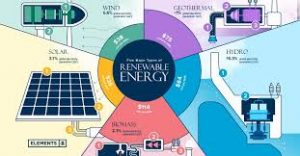
The Ministry of New and Renewable Energy is formulating a plan to create a fully indigenous solar manufacturing ecosystem by 2028, encompassing modules, cells, wafers, and ingots.
- The solar manufacturing value chain encompasses the complete process of converting raw materials into a fully functional solar photovoltaic (PV) module.
- It is a sequential workflow and the chain is generally divided into Upstream (high-tech, capital-intensive) and Downstream (labor-intensive) segments.\
- The process begins with metallurgical-grade silicon derived from quartz sand, which is then processed into polysilicon.
- The polysilicon is melted and crystallized into large, cylindrical blocks called ingots.
- Ingots are sliced into ultra-thin, disc-shaped sheets using a wire saw. These sheets, called wafers, are the fundamental building block of a solar cell.
- The wafers undergo doping (adding phosphorus and boron to form an electric field), printing (metal contacts for electron flow), and anti-reflective coating to minimize light reflection. The result is a solar cell capable of converting sunlight into electricity.
- Solar cells are interconnected, laminated, sealed between glass and polymer back sheets, and framed to form a solar module.
- Modules are assembled into arrays, connected to inverters, mounting structures, and wiring, and installed on rooftops, fields, or solar farms.
- India’s solar module capacity has already touched 100 GW, but solar cell capacity is only 27 GW, while ingot and wafer capacity is just 2.2 GW, making it heavily reliant on imports, particularly from China.
- India aims to finalize a roadmap for Swadeshi polysilicon production in the coming years.
- A key step is the proposed expansion of the Approved List of Models and Manufacturers (ALMM), currently for modules, to include solar cells, wafers, and ingots.
- ALMM mandates that solar project developers purchase equipment from approved models and manufacturers, promoting domestic manufacturing and acting as a non-tariff barrier to low-quality or import-dependent products.
Great Nicobar Island Project:
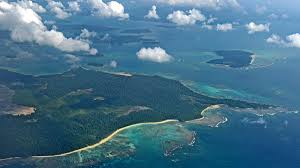
Great Nicobar Island (GNI) Project has drawn attention as one of India’s most ambitious infrastructure plans in the Indian Ocean Region (IOR).
- Despite environmental concerns, the project is crucial for turning Great Nicobar into a global maritime hub while considering ecology and tribal welfare.
- Great Nicobar Island (GNI) Project conceived by NITI Aayog and launched in 2021, aims to build an International Container Transshipment Terminal (ICTT), a greenfield international airport, a township, and a gas–solar power plant.
- It is implemented by Andaman and Nicobar Islands Integrated Development Corporation (ANIIDCO).
- It aligns with India’s Maritime Vision 2030 and is one of the key projects under the Amrit Kaal Vision 2047.
- The ICTT reduces India’s reliance on foreign ports like Singapore and Colombo, integrating India into global supply chains.
- Enhances civilian connectivity, tourism, and dual-use defence capability.
- Nicobar’s location near the Malacca, Sunda, and Lombok Straits allows India to monitor vital sea lanes for global trade and energy supply.
- Great Nicobar’s location gives India proximity to Sabang (Indonesia), Coco Island (Myanmar), and the proposed Kra Canal (Thailand), underscoring its central role in Indo-Pacific sea routes.
- Great Nicobar lies almost equidistant from Colombo, Port Klang, and Singapore, placing India at the centre of regional sea trade.
- The Andaman & Nicobar Islands serve as India’s first line of maritime defence and share sea boundaries with Myanmar, Thailand, Indonesia, and Bangladesh, giving India a vast exclusive economic zone and continental shelf under United Nations Conference on the Laws of the Sea, 1982 (UNCLOS).
- GNI strengthens India’s naval reach in the Indo-Pacific, countering piracy, trafficking, terrorism, and great-power rivalries.
- Positions India as a proactive maritime power amidst rising presence of China and other navies in the IOR.
- Supports Act East Policy (2014) and the QUAD’s Indo-Pacific strategy, strengthening India’s role in regional security.
INS Aravali Commissioned in Gurugram:
INS Aravali, Indian Navy’s latest Naval Base, was commissioned at Gurugram to strengthen Maritime Domain Awareness (MDA) capability.INS Aravali, deriving its name from the unwavering Aravali range. It is designed to strengthen the Navy’s information and communication infrastructure. It would not only be a hub of technology, but also of a collaborative vision of MAHASAGAR. The base is guided by its motto: ‘सामुद्रिकसुरक्षायाः सहयोगं’ (Maritime Security through Collaboration). It will help various information and communication centers of the Indian Navy, and strengthen India’s Command, Control, Communications, and Maritime Domain Awareness (MDA) framework. Reinforce India’s position as the Preferred Security Partner in the Indian Ocean Region.
India’s Green Finance Plan:
India is turning to Contracts for Difference (CfD) as a central mechanism to mobilize nearly USD 1 trillion in green finance for its 500 GW renewable energy target by 2030. CfD is a financial agreement between renewable energy producers and the government to stabilize revenues. If market prices fall below an agreed strike price, the government pays the producer the difference and if prices rise above it, the producer returns the surplus. CfDs reduce risk and are widely used in Europe for renewable projects. Green finance encompasses financial products and services designed to promote environmental sustainability. To meet its Paris Agreement targets, India needs USD 2.5 trillion by 2030. India needs USD 10 trillion by 2070 for its net zero goal, focusing on green finance as essential for development. India finances renewable energy through the National Clean Energy and Environment Fund (NCEEF) funded by coal cess.
Global Plastic Pollution Crisis:
Global plastic pollution is reaching alarming levels, with waste projected to triple by 2060 to 1.2 billion tonnes, posing a grave ecological threat.Global plastic production doubled between 2000–2019, touching 460 MT; this growth is driven by packaging and fast consumption.Only 9% of plastic is recycled, leading to massive leakage into landfills, rivers, and open dumps.11 MT of plastic enters oceans annually, harming marine species and contaminating the food chain.Plastics degrade into micro/nano particles that infiltrate air, water, soil, and even human blood and lungs.Without urgent reforms, OECD projects plastic waste will nearly triple by 2060, overwhelming waste systems globally.
Eustoma:
Exotic Eustoma has bloomed for the first time in Odisha in a polyhouse at Sanatanpali, Sambalpur district, developed by CSIR–NBRI. Until NBRI’s breakthrough, Eustoma (Lisianthus) was mostly imported from countries like the Netherlands and Kenya for premium events, weddings, and luxury décor.Eustoma, also known as Lisianthus or Prairie Gentian, is a herbaceous annual flower from the gentian family. It is prized globally for its long vase life and vibrant colors, making it a premium ornamental flower.
India’s First Bamboo-Based Ethanol Plant in Assam:
Prime Minister of India inaugurated India’s first bamboo-based ethanol plant at Numaligarh Refinery, Golaghat, Assam, and laid the foundation stone of a polypropylene plant. India’s First Bamboo-Based Ethanol Plant in Assam is a bioethanol plant that converts bamboo biomass into 2G ethanol, a renewable alternative to fossil fuels. Part of India’s National Bio-Energy Mission and Ethanol Blending Programme (EBP) to achieve 20% ethanol blending by 2025. Developed by Assam Bio-Ethanol Private Limited (ABEL) in collaboration with Numaligarh Refinery Ltd (NRL) under the Ministry of Petroleum & Natural Gas.
Defence Procurement Manual (DPM) 2025:
Ministry of Defence approved Defence Procurement Manual (DPM) 2025, replacing the 2009 manual to accelerate revenue procurement and promote Aatmanirbharta. A policy document guiding all revenue procurement of goods/services for Armed Forces & MoD organisations, worth ~₹1 lakh crore annually. Updated after 16 years to align with public procurement norms, technology adoption, and operational needs of modern warfare. Aim is to Streamline & Simplify: Cut red tape, enable faster approvals, and avoid file movement delays.It Address working capital issues, ease penalties, and provide order assurance. It Collaborate with IITs, IISc, academia, and industry for indigenisation.
Grey Rhino Event:
Kerala’s Wayanad landslide (July 2024) has been described as a “grey rhino event” by scientists in the report Sliding Earth, Scattered Lives (Sept 2025), highlighting how policymakers ignored years of warnings about ecological fragility and rainfall risks. A “grey rhino” is a highly probable, high-impact event that is visible and foreseeable but often neglected until it causes catastrophic damage. It contrasts with “black swan events” (rare, unpredictable) and focuses on obvious but ignored risks. Concept Developed by Coined by Michele Wucker, a U.S.-based policy analyst, in her 2016 book The Gray Rhino: How to Recognize and Act on the Obvious Dangers We Ignore.
Australia approved the world’s first vaccine to save koalas from Chlamydia:
Koala bear (Phascolarctos cinereus) is an arboreal herbivorous marsupial native to Australia.It is the only extant representative of the family Phascolarctidae and its closest living relatives are the wombats.Koalas are asocial animals, congregating only during the breeding season.They spend most of their time eating and sleeping in eucalyptus trees, and their paws have two opposing thumbs to help them grasp and climb up tree trunks.They can be found in habitats ranging from relatively open forests to woodlands, and in climates ranging from tropical to cool temperate.Koalas are distributed across eastern and southeastern Australia, including northeastern, central, and southeastern Queensland, eastern New South Wales, Victoria as well as southeastern parts of South Australia.Koalas are herbivorous (folivorous) animals, feeding primarily upon the leaves of the eucalyptus tree.Conservation status: IUCN: VulnerableThese species are facing compounded threats from disease, habitat loss, climate change and road collisions.
Chlamydia in koalas. Koalas suffer from both bacterium species Chlamydia pneumonia and Chlamydia pecorum. The disease occurs in koalas multiple ways, including through mating, infected discharges and at birth.It can cause eye infections, blindness, urinary tract problems, and even infertility.Infected koalas often become weak, dehydrated, and more vulnerable to predators and bushfires.In some areas of Australia, up to 70% of wild koalas carry the disease.Chlamydia spreads quickly in koalas because they live in overlapping territories and groom each other.
Salamis Bay:
INS Trikand, a stealth frigate of the Indian Navy, reached Salamis Bay, Greece. It will participate in the first-ever bilateral maritime exercise between India and Greece to boost interoperability and naval cooperation.Salamis Bay is natural bay on the west coast of Salamis Island, Greece, connected to the Saronic Gulf.It is Situated in the Aegean Sea region, about 16 km from Athens, near Salamis town.




